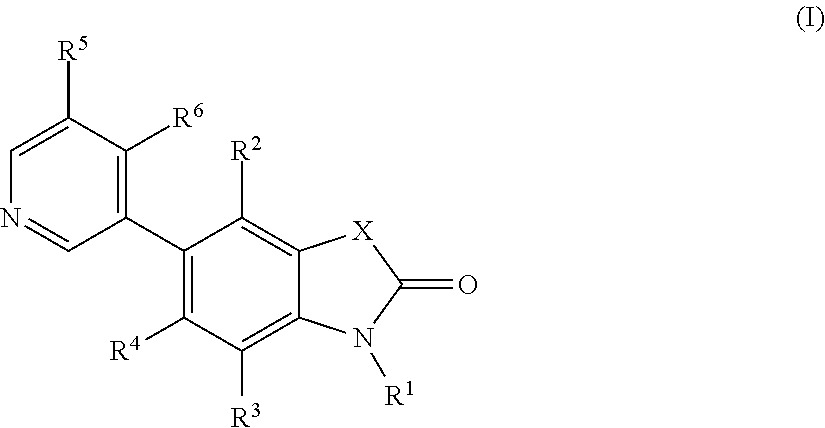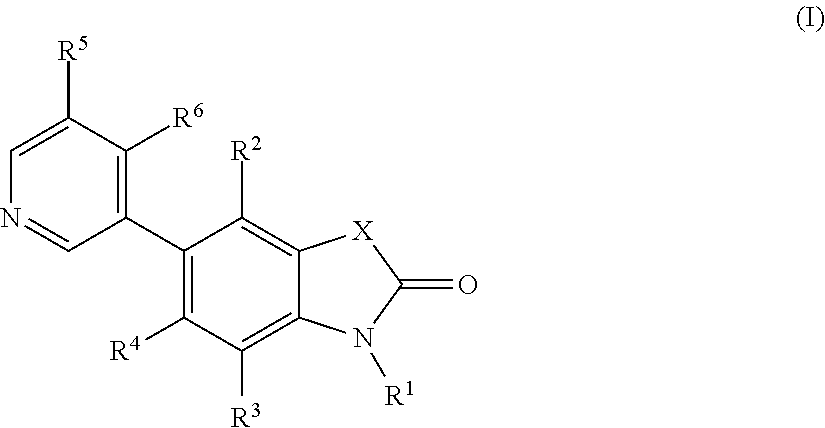5-pyridin-3-yl-1, 3-dihydro-indol-2-on derivatives and their use as modulators of aldosterone synthase and/or cyp11b1
a technology of indosterone and derivatives, which is applied in the direction of drug compositions, metabolism disorders, extracellular fluid disorders, etc., can solve problems such as gynecomastia and impotence, and achieve the effect of suppressing aldosterone production and meliorating the deleterious effects of aldosteron
- Summary
- Abstract
- Description
- Claims
- Application Information
AI Technical Summary
Benefits of technology
Problems solved by technology
Method used
Image
Examples
example 1
1-Methyl-5-(5-methyl-pyridin-3-yl)-1,3-dihydro-indol-2-one
[0247]
[0248]To 5-bromo-1-methyl-1,3-dihydro-indol-2-one (CAS#20870-90-0, 80 mg, 0.35 mmol) was added 5-methyl-3-pyridinyl boronic acid (CAS#173999-18-3, 55 mg, 0.39 mmol), in 1,2-dimethoxyethane (2.7 mL) and 2 M aqueous sodium carbonate (0.45 mL, 0.9 mmol). The reaction mixture was degassed and placed under an argon atmosphere, at which time resin bound tetrakis(triphenylphosphine)palladium(0), specifically polystyrene triphenylphosphine palladium (0) [PS—PPh3-Pd(0) (Biotage), 0.09 mmol / g loading, (195 mg, 0.018 mmol)] was added. The reaction vessel was sealed and was heated by microwave irradiation at 100° C. for 1.5 hours. The reaction mixture was cooled to room temperature, diluted with dichloromethane and filtered through glass wool. The filtrate was further diluted with saturated aqueous sodium bicarbonate and the layers were separated. The aqueous layer was extracted two times with dichloromethane, and the organic layer...
example 2
5-(5-Fluoro-pyridin-3-yl)-1-methyl-1,3-dihydro-indol-2-one
[0249]
[0250]To a solution of 5-fluoropyridine-3-boronic acid (CAS#872041-86-6, 80 mg, 0.57 mmol) in 1,2-dimethoxyethane (0.7 mL) was added water (0.3 mL) and ethanol (0.2 mL. The solution was then charged with sodium carbonate (60 mg, 0.57 mmol), 5-bromo-1-methyl-1,3-dihydro-indol-2-one (CAS#20870-90-0, 132 mg, 0.57 mmol), and dichlorobis(triphenylphosphine)palladium (II) (CAS#13965-03-2, 20.3 mg, 0.029 mmol). The reaction vessel was sealed and is heated by microwave irradiation at 150° C. for 10 minutes. The reaction mixture was cooled to room temperature, filtered and concentrated. The resulting residue was partially purified by semi-preparative reverse phase HPLC (20 to 90% acetonitrile / water vii 0.1% TEA). Final purification was accomplished via silica gel flash chromatography (methanol-dichloromethane, 0 to 7%) to afford 5-(5-fluoro-pyridin-3-yl)-1-methyl-1,3-dihydro-indol-2-one, MS: (ES+) m / z 243 (M+H)+; 1H NMR (400 MHz...
example 3
a) 1-Methyl-5-(4,4,5,5-tetramethyl-[1,3,2]dioxaborolan-2-yl)-1,3-dihydro-indol-2-one
[0251]
[0252]To a solution of 5-bromo-1-methyl-1,3-dihydro-indol-2-one (CAS#20870-90-0, 4.07 g, 18.00 mmol), in DMSO (50 mL) was added bis(pinacolato)diboron (5.03 g, 19.80 mmol), and potassium acetate (5.30 g, 54.0 mmol). Next, [1,1′-bis(diphenylphosphino)-ferrocene]-dichloropaltadium(II) complexed with dichloromethane (CAS#72287-26-4, 0.417 g, 0.540 mmol) was added. The reaction mixture was degassed by bubbling nitrogen through the solution for 3 minutes. The reaction was then heated at 80° C. for 18 hr. The reaction was then poured into ice-water and extracted three times with diethyl ether. The organic extracts were combined, washed with brine, dried over anhydrous sodium sulfate, filtered and concentrated. The resulting residue was purified by silica gel flash chromatography (ethyl acetate-heptane, 0 to 70%) to afford 1-methyl-5-(4,4,5,5-tetramethyl-[1,3,2]dioxaborolan-2-yl)-1,3-dihydro-indol-2-o...
PUM
| Property | Measurement | Unit |
|---|---|---|
| enantiomeric excess | aaaaa | aaaaa |
| enantiomeric excess | aaaaa | aaaaa |
| enantiomeric excess | aaaaa | aaaaa |
Abstract
Description
Claims
Application Information
 Login to View More
Login to View More - R&D
- Intellectual Property
- Life Sciences
- Materials
- Tech Scout
- Unparalleled Data Quality
- Higher Quality Content
- 60% Fewer Hallucinations
Browse by: Latest US Patents, China's latest patents, Technical Efficacy Thesaurus, Application Domain, Technology Topic, Popular Technical Reports.
© 2025 PatSnap. All rights reserved.Legal|Privacy policy|Modern Slavery Act Transparency Statement|Sitemap|About US| Contact US: help@patsnap.com



